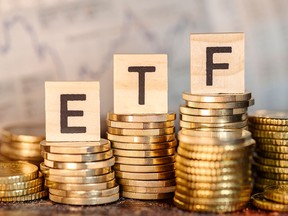Jim stopped investing in ETFs because of phantom distributions and tax issues. Was this the right thing to do?

Jim stopped investing in ETFs because of phantom distributions and tax issues. Was this the right thing to do?

Article content
Q. I have never seen an article written on the problem of phantom dividends from exchange traded funds (ETFs) in Canada. I have run into this problem and stopped investing in ETFs as a result. It is causing tax issues for me and I don’t like the non-transparency of these shares and dividends, which makes the dividends harder to keep track of. I’m also receiving Old Age Security (OAS) and wasn’t sure what effect, if any, it was having on the OAS clawback. Was this the right thing to do? —Jim
THIS CONTENT IS RESERVED FOR SUBSCRIBERS ONLY
Subscribe now to read the latest news in your city and across Canada.
- Exclusive articles from Barbara Shecter, Joe O'Connor, Gabriel Friedman, and others.
- Daily content from Financial Times, the world's leading global business publication.
- Unlimited online access to read articles from Financial Post, National Post and 15 news sites across Canada with one account.
- National Post ePaper, an electronic replica of the print edition to view on any device, share and comment on.
- Daily puzzles, including the New York Times Crossword.
SUBSCRIBE TO UNLOCK MORE ARTICLES
Subscribe now to read the latest news in your city and across Canada.
- Exclusive articles from Barbara Shecter, Joe O'Connor, Gabriel Friedman and others.
- Daily content from Financial Times, the world's leading global business publication.
- Unlimited online access to read articles from Financial Post, National Post and 15 news sites across Canada with one account.
- National Post ePaper, an electronic replica of the print edition to view on any device, share and comment on.
- Daily puzzles, including the New York Times Crossword.
REGISTER / SIGN IN TO UNLOCK MORE ARTICLES
Create an account or sign in to continue with your reading experience.
- Access articles from across Canada with one account.
- Share your thoughts and join the conversation in the comments.
- Enjoy additional articles per month.
- Get email updates from your favourite authors.
THIS ARTICLE IS FREE TO READ REGISTER TO UNLOCK.
Create an account or sign in to continue with your reading experience.
- Access articles from across Canada with one account
- Share your thoughts and join the conversation in the comments
- Enjoy additional articles per month
- Get email updates from your favourite authors
Sign In or Create an Account
or
Article content
Article content
FP Answers: By phantom dividends, I believe you are referring to phantom distributions, Jim. Phantom distributions occur when a managed product, such as an exchange traded fund (ETF) or mutual fund sells one of its underlying securities for more than its purchase price. Essentially, it is when a fund you own has a capital gain on an investment it owns.
Article content
Article content
By signing up you consent to receive the above newsletter from Postmedia Network Inc.
Article content
The proceeds of that sale are reinvested in the fund, and no cash payment is made in most cases. As a result of this reinvestment, your adjusted cost base (ACB) would increase due to the reinvestment of the capital gain proceeds.
Article content
Phantom distributions can also happen because of corporate actions such as mergers and acquisitions that may result in the amalgamation or delisting of securities that result in capital gains. Although the investment returns are surely welcome, there will be taxable income that results from these capital gains distributions if these securities are held in taxable investment accounts.
Article content
In Canada, the taxation of ETFs and mutual funds should result in similar after-tax returns as if the securities they hold were owned individually. For example, if a Canadian bank ETF has an effective yield of four per cent, and investors hold the same proportion of the bank stocks underlying the ETF, they should also have a comparable yield with the same tax payable. The fund may sell a stock it owns and generate a taxable capital gain for the investor if it is held in a taxable account and this unexpected aspect of an ETF or mutual fund can surprise an investor. The taxable income is not exactly phantom income though because it is an actual capital gain the investor would have had if they owned and sold the same stock themselves.
Article content
Article content
Most ETFs are designed to distribute income back to the unitholders in cash or as reinvested units. Common sources of income from ETFs are interest from bonds or dividends from stocks. This income may also be reinvested within the fund, but again, it is income nonetheless, despite investors not receiving it in their hands.
Article content
Article content
For broad-based market ETFs, it’s unlikely that you will have a huge amount of capital gains from year to year. There are rarely large capital gains from year to year, but rather, rebalancing that triggers modest gains. On the other hand, if you purchase a factor-based ETF that employs active strategies these may result in more trading in the fund and higher capital gains from year to year. I recommend reviewing the trading exchange ratio (TER) or turnover rate of funds that you are purchasing in a taxable account, as this may be indicative of what you can expect.
Article content
Mutual funds, active and passive, will have similar attributes to ETFs, with more sporadic capital gains typically associated with active funds compared with passive funds. In situations like these I would always evaluate the materiality of the issue versus the alternative. For example, are you content with your portfolio’s risk/return profile, and is there a suitable alternative to avoid the phantom income?




